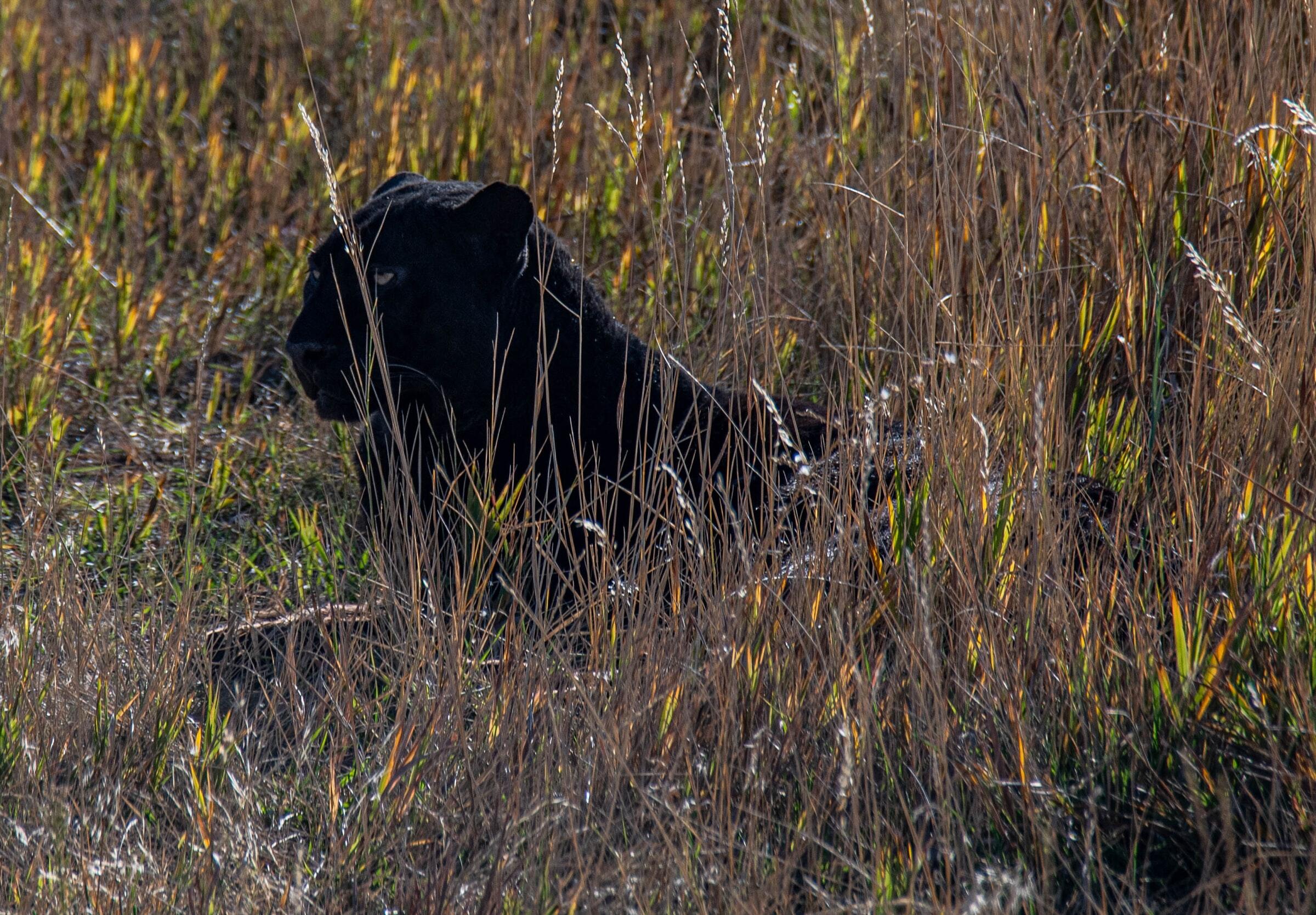For years now, claims have poured in about giant panther-like cats roaming around England, but is there truth to the sightings?
W
hat might you expect to find if you go down to the wild woods of southwest England? Sunlight dappling the forest floor. Bluebells blossoming in spring. Rabbits scattering as your boots crunch the twigs beneath your feet. Even, perhaps, the retreating haunch of a red deer—Britain’s largest wild animal. Certainly, nothing in this sylvan scene would cause you to look over your shoulder for fear of being stalked or ambushed. Since bears and wolves were hunted to extinction in the Middle Ages, Britain has been free of large apex predators. The same era saw the demise of the Eurasian lynx, once the British Isles’ largest indigenous felid, which resembles an oversized and sandy housecat with pointed black ears. Since its extinction around 1,300 years ago, there have been no big wild cats in Britain. Or have there?
Sightings of big cats have been reported in Britain for centuries but have really gathered pace in the second half of the 20th century, surging in the last two years during the COVID pandemic. There have been dozens of reported sightings in London since 2015, but reports from rural areas are much more common (particularly in the southwestern counties of Devon and Cornwall, where hundreds have claimed to see big cats roaming around the countryside).
Recommended Fodor’s Video
Curiously, most of them do not describe lynx or any big cat known to have been native to Britain. Instead, the claims describe a big cat resembling a black panther, which is relatively rare in the wild, even in their native ranges.
“I’ve had about 1,400 reports since 2005,” said Rick Minter, host of the Big Cat Conversations podcast. “About three-quarters of them are big, black cats, about the size of a stretched labrador, with a long, tubular tail.”
It was exactly this animal profile that Minter saw himself while working in countryside management on behalf of the British government.
“One day, I took a bloke for a meeting, and I was at the back of a hotel looking out at the fields,” Minter said. “About 300 feet away was what I thought was a black labrador, in profile. It was walking slowly, confidently—nonchalantly, really—and for five seconds, I thought, ‘That’s a funny-looking, low-slung black labrador.’ I had plenty of time to assess it and realize there were no owners about. I felt a bit on edge as I confirmed to myself, ‘Yes, that’s a big cat—they do exist.’”
Minter added that the other 25% of sightings are made up of lynx-type cats and those resembling pumas (also known as cougars or mountain lions).
Big Cats and British Folklore
Reports are so widespread that they are impossible to ignore and are not the preserve of fringe eccentrics.
Big cat stories pass with unusual rapidity into the realm of popular folklore. When mutilated sheep and cattle were found scattering the wilderness of Cornwall’s Bodmin Moor in the late 1970s, combined with a number of reported sightings of panther-like black cats, it wasn’t long before the “Beast of Bodmin Moor” had become entrenched in local legend. Around the same time, a slew of similar sightings was reported in Exmoor, the nearby counties of Devon and Somerset. When a farmer reported losing 100 sheep to mysterious throat injuries, the “Beast of Exmoor” was born. Eyewitness accounts were often ornamented with details on the supernatural, such as the addition of disembodied blood-curdling screams or the rising of a blood moon. Such flights of fancy have given British big cats a position in the realm of cryptozoology in many people’s minds, along with the Yeti, Bigfoot, and Loch Ness monster. Except that these cats are different. Their existence is supported by a weight of evidence, which separates them from most urban legends.
On rare occasions, specimens have been caught. In 1980, a puma was captured in the Scottish countryside after farmers reported finding their sheep mutilated with crushed bones. Also, in Scotland, a lynx was discovered in 1927, and a large hybrid animal called the Kellas cat (once thought to be a fanciful myth) was trapped by a gamekeeper in 1984. Genetic testing revealed the animal to be a cross between a domestic cat and a European wildcat. Reports are so widespread that they are impossible to ignore and are not the preserve of fringe eccentrics. Highly credible witnesses include countryside management experts such as Minter and Ministry of Defense policeman Chris Swallow, who filmed what he believed to be a big cat crossing a railway line in Argyll, Scotland.
The Release/Escapee Theory
It may be no coincidence that the sightings of big cats began to surge in the 1970s. In the latter half of the 20th century, particularly during the uninhibited 1960s, there were few laws restricting the ownership of exotic pets. A common sight in Hyde Park in 1968 was secretary Angela McWilliams walking (or being walked by) her pet leopard, Michael. The famous feline Christian the lion, who would later become a YouTube sensation after recognizing his owners decades after being reintroduced into the wild, was purchased from Harrod’s department store in 1969 and raised in a London apartment.
Everything changed in 1976 with the introduction of the Dangerous Wild Animals Act, which made it illegal to own big cats without a license. The prevailing theory among researchers is that many big cats were released from private homes around this time, accounting for the increase in sightings from the late 1970s onwards.
“I don’t think that any of the big cats present in Britain are wild,” explained Rhoda Watkins, a tracker, and naturalist based in Cornwall. “They are all escapees or released from zoos and private owners, or the offspring of those cats. A lot were released in the late ’70s after the Dangerous Wild Animals Act came into play.”
This touches on what, for big cat researchers, is the million-dollar question: are there breeding populations in the British countryside? Leopards, jaguars, and pumas have a lifespan of 10 to 15 years in the wild, meaning that any cats released in the immediate wake of the 1976 legislation would be long gone. The idea that they may have established breeding populations and that modern sightings may be descendants of those original cats is tantalizing but does not necessarily follow. “
There are still cats in private homes and wildlife parks that could be released or escape to this day,” said Watkins. “Not everyone is licensed as they should be to own them.” According to animal rights charity Born Free, in 2021, 61 big cats were being kept legally as pets in Britain, including 11 leopards, 18 pumas, and a jaguar. That’s not accounting for the illegal wildlife trade, worth some $7 billion globally each year. It’s possible that continued sightings of big cats can be explained by new escapees, although that still doesn’t explain the unusual prevalence of black cats, which only account for 11% of the wild leopard population.
The Skeptical View
Environmentalist George Monbiot claims that the oft-reported black cats do not exist at all, citing the lack of physical evidence such as hairs, scat, scratch marks, and scent. He argues that imagined sightings reflect a predator-shaped hole in our tame modern lives, and “reawaken old genetic memories of conflict … with large predatory cats.”
The British government’s response on the matter is similarly skeptical. In March 2022, a government spokesperson told Cheshire Live that big cat sightings are “taken seriously and investigated thoroughly” but that “in all cases reported in recent years, there has been no credible evidence supplied that would justify any action.”
For now, at least, Britain’s big cats—whether real or mythological—remain an enigma, one unlikely to go away any time soon.




